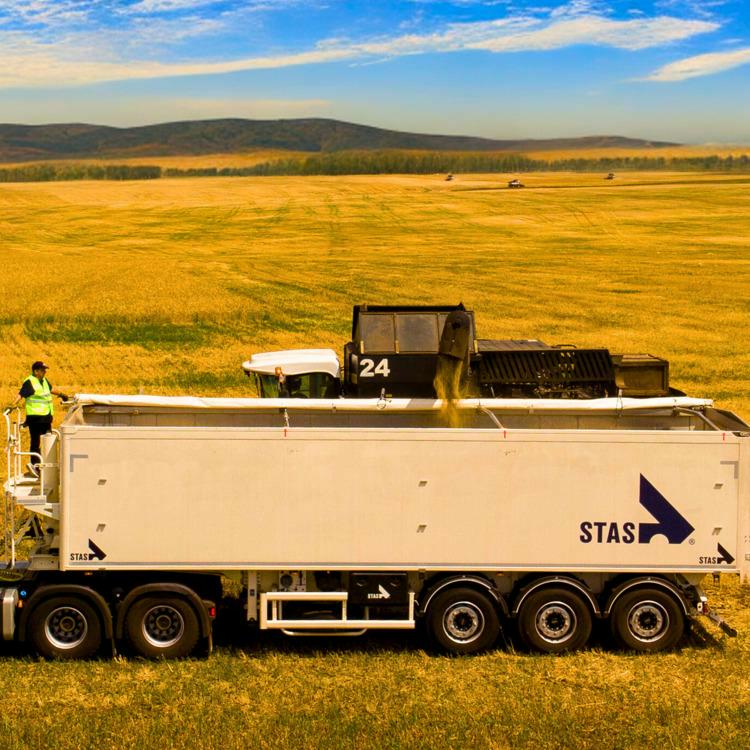How to prepare your trailer for winter

Winter is coming, and that means it's time to winterise your semi-trailer. By maintaining it properly, you will ensure it remains safe and reliable during the cold winter months. We're here to help you get started.
Check the trailer
Before you head into winter, it's a good idea to give your entire trailer a check-up. Consider the following parts:
- Check tyres regularly for wear, damage, tyre tread depth and pressure (which depends on the type of vehicle and load). Read more about TPMS and TPRS systems to keep tyre pressure in top condition.
Depending on the region, it may be interesting to change to winter tyres. Be sure to check legislation to see if it might be mandatory in the areas you’re going. - Brakes are essential for safety. Make sure the brakes are working properly before heading out for the winter. Check the air pressure so you can hit the road with confidence. Check the brake discs and pads. If the brake discs or pads are too worn, they should be replaced.
- Check the chassis and trailer body of your tipping trailer or walking floor trailer for damage. Clean everything thoroughly first and then examine the trailer in detail. If you find damage, it should be repaired before you hit the road.
- Good lighting ensures you are visible to other road users during the dark winter months and that you can see what’s happening during loading and unloading. So regularly check all lights, both at the front of the truck and the side lights, the work lights and, of course, the lights at the back. When doing so, pay attention to damage to the casing and the performance of the lights. Also, check for condensation which may indicate water seepage which can cause long-term electrical damage.
Would your vehicle benefit from proper maintenance? Contact your nearest STAS dealer to schedule maintenance and any repairs.
Antifreeze: your best friend during winter
Does your semi-trailer have a water tank, high-pressure washer, water hose or rear water tap? Add antifreeze to the water tank to prevent the water supply from freezing. Add the antifreeze to the tank and push the mixture through the pipes, this way the antifreeze can spread throughout the entire system, and everything is protected. Trying to get all the water out of the pipes is not recommended as there will always be some water left behind that can freeze and cause damage. Also, remember to vent the filter at the bottom of the pressure washer.

Remove ice from the sheeting system
For both tipping trailers and walking floor trailers, it is best to check for ice on the sheeting system before you leave. Ice can form during the night. If you drive, you may cause damage to other vehicles or people. It’s best to remove the ice before you hit the road. Of course, you can also avoid ice on the cover system by parking the vehicle inside or opening the sheeting system at night and closing it again before you leave.

Remove water from compressed air tanks
Before winter strikes, it's best to remove the water from the compressed air tanks. How do you do this? Disconnect both compressed air lines and pull the drain pins at the bottom of the air tanks until only air escapes.
Floor cylinders of walking floor trailer
Are you driving during freezing temperatures? Then ensure the floor cylinders are fully retracted with the floor profiles as close to the rear door as possible. Salt and water on the road are bad news for the cylinder rods. If these start to rust, you create accelerated wear on the cylinder gaskets, eventually resulting in leakage and environmental pollution.
Don't forget yourself!
Also, remember to protect yourself from the cold as much as possible. Make sure you have gloves, a hat, a scarf and a warm jacket with you when you go out during winter. Consider waterproof shoes if necessary. This will prevent hypothermia, stiff muscles and loss of concentration. Stay nice and warm which makes it a lot more comfortable for yourself. Fortunately, STAS merchandise can help you to keep warm.
What if...?
... the brakes are frozen solid
First, try knocking the ice off the callipers with a hammer. Didn’t work? Then spray some hot (not boiling!) water on the frozen parts. Do this gradually so as not to damage any trailer parts.
... the door is frozen solid
The biggest enemy of ice is... hot (not boiling) water! Here it’s best to use hot water or antifreeze to loosen the door. Do not use a hammer; you can seriously damage the door.
... the moving floor is frozen solid with the load in it
Unfortunately, there is nothing else to do but to place the vehicle with its load inside and wait for it to thaw completely. If the need is high, you can always try to free the load with logistics equipment. Just be careful not to damage the trailer!
... the moving bulkhead of your walking floor trailer freezes solid?
In winter, it is recommended to have antifreeze on hand. If the moving bulkhead freezes in the rail, you can spray some antifreeze (or hot - not boiling - water) into the rail to loosen it up. Do be careful on the catwalk and inside the trailer body as they can become very slippery. So be wary!
With these tips, you are well prepared to get through the winter with your tipping trailer or walking floor trailer. By maintaining your trailer correctly and regularly and protecting yourself properly from the cold, you can continue to drive safely and comfortably even during the coldest winter months. Once winter is over, you can look ahead to the summer months: Summer trailer prep: essential tips for a smooth journey.






